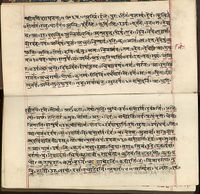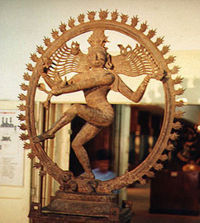Hinduism
2007 Schools Wikipedia Selection. Related subjects: Religious movements, traditions and organizations
Hinduism (Sanskrit: हिन्दू धर्म, Hindū Dharma, also known as सनातन धर्म, Sanātana Dharma) is a religion that originated on the Indian subcontinent. Hinduism encompasses many religious beliefs, practices, and denominations. Most Hindus believe in a supreme cosmic spirit called Brahman that is worshipped in many forms, represented by individual deities such as Vishnu, Shiva and Shakti. Hinduism centers around a variety of practices that are meant to help one experience the divinity that is everywhere and realize the true nature of the Self.
Hinduism is the third largest religion in the world, with approximately 1 billion adherents (2005 figure), of whom about 890 million live in India. Other countries with large Hindu populations include Nepal, Bangladesh, Pakistan, Sri Lanka, Indonesia, Malaysia, Singapore, United Kingdom, Canada and the United States, with Nepal being the only country with Hinduism as its official religion (see article Hinduism by country).
Hinduism is considered to be the oldest living religion in the world. Unlike most other major religions, Hinduism has no single founder and is based on a number of religious texts developed over many centuries that contain spiritual insights and practical guidance for religious life. Among such texts, the Vedas are the most ancient. Other important scriptures include Upanishads, the eighteen Puranas and the epic poems Mahabharata and Ramayana. The Bhagavad Gita, which is contained within the Mahabharata, is a widely studied scripture that summarizes the spiritual teachings of the Vedas.
Core concepts
Modern Hinduism evolved from the ancient Vedic tradition (Vaidika paramparā). Prominent themes in Hinduism include Dharma (individual ethics, duties and obligations), Samsāra (rebirth), Karma (right action), and Moksha (salvation). Buddhism, Jainism and Sikhism all share some traits in common with Hinduism, as all these religions originated in India, and all focus on self-improvement with the ultimate aim of attaining personal spiritual experience.
God & the soul
God: both principle and person
Hinduism is sometimes referred to as a polytheistic religion, but strictly speaking, this is not accurate. Mainstream Hinduism believes in One God, but asserts that the One God can appear to humans in multiple names and forms.
Brahman
According to the monotheistic and pantheistic theologies of Hinduism, God is, in the highest sense, One: beyond form, infinite, and eternal. God is changeless and is the very source of consciousness. God is beyond time, space, and causation and yet permeates everything and every being. God is beyond gender. When God is thought of as this infinite principle, God is called Brahman. Brahman is the Absolute reality: it is pure existence and knowledge. Brahman does not exist; it is existence itself. It is not all-knowing; it is knowledge itself.
However, when human beings try to think of the infinite God, they project the limitations of their finite minds on God. The human mind cannot think other than in human terms. Therefore, it projects human limitations, such as personality, motherhood, and fatherhood on God. According to the Advaita school of thought God does not have any such attributes. However, many consider it helpful to project such attributes on God — the myriad names and forms of God one finds in Hinduism are all ways for humans to approach the divine. Therefore, the Hindu scriptures depict God not only as an abstract principle or concept, but also as a personal being, much like the God in the Judeo-Christian religions.
Despite Hinduism's belief in the abstract principle of Brahman, most Hindus worship God on a day-to-day basis in one of God's less abstract personal forms, such as Vishnu, Shiva, or Shakti. Some Hindus worship these personal forms of God for a practical reason: it is easier to cultivate devotion to a personal being than to an abstract principle. Other Hindus, such as those following the Dvaita traditions, consider the personal forms in themselves to be the highest form of truth and worship God as an infinite and yet personal being.
The Hindu scriptures declare that Brahman (the impersonal God) is beyond description, and can be understood only through direct spiritual experience. Nevertheless, for the benefit of others, the ancient Hindu sages who experienced Brahman attempted to describe their experiences, as recorded in the ancient Vedic texts known as the Upanishads.
Several mahā-vākyas, or great sayings, indicate what the principle of Brahman is:
- "Brahman is knowledge", (prajnānam brahma)
- "The Self (or the Soul) is Brahman " (ayam ātmā brahma)
- "I am Brahman" (aham brahmāsmi)
- "You are that" (tat tvam asi),
- "All this that we see in the world is Brahman" (sarvam khalv idam brahma),
- "Brahman is existence, consciousness, and happiness" (sachchidānanda brahma).
Thus, Brahman is conceived of as the very essence of existence and knowledge, which pervades the entire universe, including every living being. The goal of Hinduism is to somehow "wake up," and realize one's own connection to the divine reality that may be called Brahman or God. Because God is everywhere, God is also present within each living being.
Ishvara

When God is thought of as the supreme all-powerful person (rather than as the infinite principle called Brahman), God is called Īśvara or Bhagavān. Īśvara is a word used to refer to the personal aspect of God in general; it is not specific to a particular deity. Īśvara transcends gender, yet can be looked upon as both father and mother, and even as friend, child, or sweetheart. Most Hindus, in their daily devotional practices, worship some form of this personal aspect of God, although they believe in the more abstract concept of Brahman as well. Sometimes this means worshiping God through an image or a picture. Sometimes it just means thinking of God as a personal being.
Depending on which aspect of Īśvara one is talking about, a different name will be used—and frequently a different image or picture. For instance, when God is spoken of as the creator, God is called Brahmā. When spoken of as preserver of the world, God is called Vishnu. When spoken of as destroyer of the world, God is called Shiva.
Many of these individual aspects of God also have other names and images. For example, Krishna and Rama are considered forms of Vishnu. All the various deities and images one finds in Hinduism are considered manifestations of the same God, called Īśvara in the personal aspect and Brahman when referred to as an abstract concept.
In their personal religious practices, Hindus worship primarily one or another of these deities, known as their "ishta devatā," or chosen ideal. The particular form of God worshipped as one's chosen ideal is a matter of individual preference. Regional and family traditions can influence this choice. Hindus may also take guidance about this choice from their scriptures.
Although Hindus may worship deities other than their chosen ideal from time to time as well, depending on the occasion and their personal inclinations, they are not required to worship—or even know about—every form of God. Hindus generally choose one concept of God (e.g., Krishna, Rama, Shiva, or Kali) and cultivate devotion to that chosen form, while at the same time respecting the chosen ideals of other people.
Devas & devis
The Hindu scriptures speak of many individual deities, called devas. Goddesses are called devīs. The various devas and devīs are personifications of various aspects of one and the same God ( Ishvara). For instance, when a Hindu thinks of Ishvara as the giver of knowledge and learning, that aspect of Ishvara is personified as the deity Saraswati. In the same manner, Lakshmi personifies Ishvara as the giver of wealth and prosperity. This does not imply that Ishvara is the Lord of all the other deities; Ishvara is just the name used to refer to the personal God in general, when no particular deity is being referred to.
The devas (also called devatās) are an integral part of the colorful Hindu culture. These various forms of God are depicted in innumerable paintings, statues, murals, and scriptural stories that can be found in temples, homes, businesses, and other places. The scriptures recommend that for the satisfaction of a particular material desire a person may worship a particular deity. For example, shopkeepers frequently keep a statue or picture of the devi Lakshmi in their shops. The elephant-headed deva known as Ganesha is worshipped before commencing any undertaking, as he represents God's aspect as the remover of obstacles. Students and scholars may propitiate Saraswati, the devi of learning, prior to an exam or lecture.
The most ancient Vedic devas included Indra, Agni, Soma, Varuna, Mitra, Savitri, Rudra, Prajapati, Vishnu, Aryaman and the Ashvins; important devīs were Sarasvatī, Ūṣā and Prithvī. Later scriptures called the Purānas recount traditional stories about each individual deity.
Vishnu and Shiva are not regarded as ordinary devas but as Mahādevas ("Great Gods" ) because of their central positions in worship and mythology. The Purānas also laud other devas, such as Ganesha and Hanumān, and avatāras such as Rāma and Krishna (see below). Goddesses are worshiped when God is thought of as the Universal Mother. Particular forms of the Universal Mother include Lakshmī, Sarasvatī and Parvatī, Durgā, and Kālī.
Some Hindus consider the various deities not as forms of the one Ishvara, but as independently existing entities, and may thus be properly considered polytheistic.
Avataras (incarnations of God)
Many denominations of Hinduism, such as Vaishnavism and Smartism, teach that from time to time God comes to Earth as a human being to help humans along in their struggle toward enlightenment and salvation ( moksha). Such an incarnation of God is called an avatāra. In some respects, the Hindu concept of avatara is similar to the belief found in Christianity that God came to the earth in the human form of Jesus. However, whereas most Christians believe that God has assumed a human body on only one occasion, Hinduism teaches that there have been multiple avatars throughout history, and that there will be more in the future. Thus Krishna, an incarnation of God, says:
Whenever righteousness declines
And unrighteousness increases,
I make myself a body;
In every age I come back
To deliver the holy,
To destroy the sin of the sinner,
To establish righteousness.
The most famous of the divine incarnations are Rama, whose life is depicted in the Ramayana, and Krishna, whose life is depicted in the Mahabharata and the Srimad Bhagavatam. The Bhagavad Gita, which contains the spiritual teachings of Krishna, is one of the most widely-read scriptures in Hinduism.
Ātman
Most Hindu thinkers agree that the spirit or soul, the true "self" of every person, called the ātman, is eternal. It is believed that the Spirit of God and the spirit of man have existed and will continue to exist throughout all eternity. According to schools influenced by the concept of Advaita (non-duality), the human spirit and God's Spirit are not seen as ultimately distinct. They believe that the core spirit, or "Self", of every individual person is identical with God's Spirit. According to the Upanishads, whoever gains insight into the depths of his own nature and becomes fully aware of the ātman as the innermost core of his own Self will also realize his identity with Brahman, the divine source of the whole universe, and will thereby reach salvation. According to the Dvaita ("dualistic") school, on the other hand (often associated with the Vaishnava tradition), the ātman is not identical with God, although it is dependent on Him, and salvation depends on the cultivation of love for God and on God's grace.
Heaven and hell
The concepts of "Heaven" and "Hell" do not translate directly into Hinduism and reaching heaven is not necessarily considered the ultimate goal. This is because heaven and hell are believed to be temporary. The only thing that is considered eternal is divinity, which includes God as well as the ātman (the soul). Therefore the ultimate goal is to experience divinity.
Hindu scriptures
Hinduism is based on "the accumulated treasury of spiritual laws discovered by different persons in different times." The scriptures were transmitted orally, in verse form to aid memorization, for many centuries before they were written down. Over many centuries, the teachings were refined by other sages, and the canon expanded.
The overwhelming majority of the sacred texts are composed in the Sanskrit language. Indeed, much of the morphology and linguistic philosophy inherent in the learning of Sanskrit is sometimes claimed to be inextricably linked to study of the Vedas and relevant Hindu scriptures. Sanskrit continues to be used even today in religious and literary settings.
The scripture are collectively referred to as Shāstra and are commonly classified into two classes: Śruti and Smriti.
Shruti (Vedic literature)
Śruti ("that which has been heard") refers to the Vedas (वेद, "Knowledge") which form the earliest record of the Hindu scriptures. While they have not been dated with much certainty, even the most conservative estimates date their origin to 1200 B.C. or earlier.
The Vedas are said to be eternal truths that were originally realized through deep meditation by ancient sages called Ṛiṣhis. Hindus do not believe that God or any person created the Vedas; the Vedas are said to be without beginning and without end. "Just as the law of gravitation existed before its discovery and would exist if all humanity forgot it, so is it with the laws that govern the spiritual world." The Vedas have therefore been called apaurusheya ("not man-made").
The Vedas themselves have been classified in various ways. One simple way is to divide the Vedas into two sections according to their subject matter:
- The Karma Kānda ("the action part"), deals with karma, rituals, and secular topics, the purpose of which is to attain material prosperity and happiness on earth, and
- The Jnāna Kānda ("the knowledge part"), is concerned with the spiritual knowledge that brings liberation from ignorance and realization of the Ultimate Truth.
The Upaniṣhads constitute a major portion of the Jnāna Kānda, and contain the bulk of the Vedas' philosophical and mystical teachings. The teachings of the Upanishads emphasize several key points (which are interpreted variously by various schools of thought):
- The deepest source of all reality, called Brahman, is identical with the innermost self of man (ātman).
- As long as one does not realize this relationship, one is subject to a seemingly endless round of rebirths (sansāra).
- A conscious realization of the essential identity of the ātman and Brahman leads to liberation from sansāra.
While the Vedas are not themselves commonly read by a lay Hindu, they are yet revered as the spiritual foundation for the later, more widely-read scriptures ( smriti).
Smriti
Hindu texts other than the Shrutis are collectively called the Smṛitis ("memory"). All of them laud the Vedas and the Shruti is generally held to take precedence over them in any apparent dispute.
The most notable of the Smritis are the Itihāsas ( epics), such as the Mahābhārata and the Rāmāyaṇa, considered sacred by almost all Hindus. Bhagavad Gītā (भगवद् गीता) (often referred to as simply the Gītā) is an integral part of the epic Mahābhārata and one of the most popular sacred texts of Hinduism. It contains philosophical sermons taught by Kṛiṣhṇa, an incarnation of Viṣhṇu, to the Pāṇḍava prince Arjuna on the eve of a great war. The Bhagavad Gītā is described as the essence of the Vedas.
Also widely known are the eighteen Purāṇas ("ancient histories"), which illustrate Vedic ideas through vivid narratives dealing with deities, and their interactions with humans. Prominent Purāṇas include the Srīmad Bhāgavatam, the Devī Mahātmya (an ode to God as the Divine Mother), the Yoga Sūtras (a key meditative yoga text by the sage Patañjali), the Tantras, and the Manusmṛiti, as well as the Mahanirvāṇa Tantra, Tirumantiram and Shiva Sūtras. Other important Hindu scriptures include the sectarian Hindu Āgamas that dedicated to rituals and worship associated with Viṣhnu, Shiva and Devī.
Most Hindu scriptures, especially the epics and Puranic stories, are not typically interpreted literally and most Hindus attach greater importance to the ethics and the metaphorical meanings derived from them. It is widely understood accepted that the Shastras contain a mix of historical fact, myth, and spiritual truths and that their aim is to highlight deeper spiritual meaning through the stories and teachings. Hindu exegesis often leans toward figurative interpretations of scriptures rather than literal ones.
Many scriptures, many paths
In contrast to the scriptural canons in some other religions, the Hindu scriptural canon is not closed even today — Hindus believe that because the spiritual truths of the Vedas are eternal, they may continue to be expressed in new ways in the future. New scriptures may continue to be written to express the truths of the Vedas in ways that will be accessible to the people of different times and places. However there is a special veneration for the shruti scriptures because they have been validated by many sages and thinkers over the course of many millennia.
Many Hindus may even venerate the scriptures of other religions, since it is believed that the One Divinity can reveal itself in innumerable ways. A much-quoted pada (verse) from the Rigveda that emphasizes the diversity of paths to the one goal is:
- ekam sat viprā bahudhā vadanti
- Truth is one, the wise call it by many names
- — Rig Veda 1.164.46c
- Truth is one, the wise call it by many names
Thus, Hinduism accepts a large number of scriptures, and remains open to any new revelations. Because the same eternal spiritual truths can be viewed from innumerable perspectives, there is relatively little theological quarrel among Hindu denominations. However, some denominations may be more inclined toward this all-inclusive attitude than others. For instance, although followers of Advaita Vedanta and Smartism often place heavy emphasis on the view that God can be worshipped in any form, many members of the Vaishnava sect believe that spiritual liberation can be attained only through submission to God in the form of Vishnu.
It is believed that a sage today can realize the same truths that the ancient rishis realized. For this reason, Hindus may venerate the words of a modern saint — Sri Ramakrishna, Sai Baba, or Sri Ramana Maharshi, for example — as much as those of the ancient teachers.
The goal of life (jīvan-lakshya)
The goal of life is stated variously as the realization of one's union with God, attainment of the vision of God, attainment of perfect love of God, realization of the unity of all existence, perfect unselfishness, liberation from ignorance, attainment of perfect mental peace, or detachment from worldly desires. The goal is to have the direct experience of divinity, regardless of precisely how one may choose to define it. The experience of divinity is the only thing that can give one true peace and happiness, and salvation from suffering and ignorance. According to Hindu thought, one does not necessarily have to wait until death to attain salvation — it is possible to achieve it in this very life. One who attains salvation while living is called a jīvan-mukta.
Multiple ways to reach the goal (yoga)
In whatever way a Hindu might define the goal of life—and multiple definitions are allowed—there are several methods ( yogas) that have been developed over the centuries for people of different tastes and temperaments. Paths one can follow to achieve the spiritual goal of life include:
- Bhakti Yoga (the path of love and devotion),
- Karma Yoga (the path of right action),
- Rāja Yoga (the path of meditation) and
- Jñāna Yoga (the path of knowledge).
An individual, or sect of Hinduism, may prefer one of yogas according to their inclination and understanding, for instance some followers of the Dvaita school hold that Bhakti ("devotion") is the only path to salvation. However, typically, practice of one yoga does not exclude acceptance of the other yogas.
Bhakti Yoga
The bhakti traditions emphasize cultivation of love and devotion for God as the path to perfection. Followers of bhakti ("bhaktas") typically worship God as a divine personal being or avatar, such as Rama or Krishna. Followers of the bhakti path strive to purify their minds and activities through the chanting of God's names ( japa), prayer, the singing of hymns ( bhajan), and by treating all living creatures with compassion (dayā). Bhaktas seek to enjoy a loving relationship with God, rather than seeking to merge their consciousness with the supreme Brahman as the followers of jnana yoga do.
Karma Yoga
The followers of karma yoga seek to achieve mental equilibrium and perfect unselfishness by performing their duties in the world in a dedicated but mentally detached manner. According to Hinduism, work, which is inevitable, has one great disadvantage. Any work done with attachment to its fruits generates a kind of psychological bondage, or anxiety, in the mind of the worker. Therefore, followers of karma yoga emphasize the following injunction in the Bhagavad Gita:
Do your duty, always; but without attachment. That is how a man reaches the ultimate truth; by working without anxiety about results.
Many followers of karma yoga try to attain mental detachment from the results of their work by mentally offering the results of every action to God, thus combining karma yoga with bhakti yoga. However, it is possible for even an atheist to follow karma yoga by simply remaining mentally detached from the results of his or her work by means of willpower.
Raja Yoga
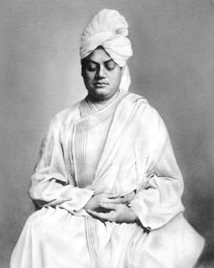
The followers of Raja yoga seek to realize spiritual truths through meditation. Raja yoga, also known simply as yoga, is based on the Yoga Sutras (aphorisms on yoga) of the sage Patanjali. Through the practice of meditation, followers of this path seek to gradually gain control over their own thoughts and actions, rather than being controlled by their impulses. They seek to attain one-pointed concentration and perfect equanimity of mind. Ultimately, through meditation, the followers of raja yoga seek self-knowledge: by concentrating all the energies of the mind inward, they seek to perceive whether they have souls, "whether life is of five minutes or of eternity, and whether there is a God." Thus, the highest goal of raja yoga is God-realization, or experiencing the Ultimate Truth.
The actual act of sitting down for meditation, however, is only the tip of the iceberg in raja yoga. The disciplines of raja yoga, as taught by Patanjali, consist of eight steps, of which dhyāna (meditation) is only one. Thus according to Patanjali, the eight practices of raja yoga are:
- Yama: Restraining harmful thoughts and impulses.
- Niyama: Cultivating good habits.
- Āsana: Learning proper posture for prolonged meditation.
- Prānāyama: Control of prana, or life force, through rhythmic breathing exercises.
- Pratyāhāra: Withdrawing the senses from their objects of enjoyment.
- Dhāranā: Fixing the mind on the object of contemplation.
- Dhyāna: Uninterrupted contemplation (meditation).
- Samādhi: Total absorption of the mind in the object of contemplation.
As with the other yogas, raja yoga may be combined with bhakti yoga, karma yoga, or jnana yoga to create a customized path suitable for an individual aspirant. The aspects of raja yoga that deal with physical exercises (especially āsana) are known collectively as hatha yoga. With the increasing popularity of the therapeutic benefits of Hatha Yoga, the sanskrit term Yoga is often interpreted in the narrow sense of Hatha Yoga. However, yoga encompasses a broader meaning in Hinduism.
Jnana Yoga
Jnana Yoga has been called the path of rational inquiry, and is prescribed for people to whom reason appeals more than faith. The followers of jnana yoga emphasize a two-step process to help one attain salvation:
(1) Viveka: the practice of discriminating between things that are impermanent (e.g., worldly pleasures) and those that are permanent (e.g., God and the soul), and
(2) Vairāgya, renunciation of unhealthy attachment to things that are impermanent.
For monks (called sanyāsīs or sādhus) and nuns (sanyāsinīs), renunciation may mean actual physical departure from worldly activities such as marriage and earning money. For the vast majority of people, however, renunciation means mental detachment from selfish desires while continuing to fulfill family and community obligations. By focusing the mind on Divinity instead of the desire for selfish gain, jnana yogis seek to maintain a healthy mental equilibrium in the face of the inevitable highs and lows of life.
According to Hinduism, humans identify themselves with their physical bodies and their egos (the sense of "I" and "mine") due to ignorance (or māyā). These attributes are considered impermanent, and thus ultimately unreal. The true "self" of every person — the only part of a person that is permanent — is the soul, called the atman. Further, it is postulated that the atman of each person is eternally connected to the atman of every other person, with God, and with all existence.
In an analogy attributed to Swami Vivekanand each individual soul is compared to a wave on a shoreless ocean. The ocean is the Infinite Brahman. When a person sees rightly, he comes to understand that each wave is part of the ocean. Similarly, the highest realization that the followers of jnana yoga strive to attain is that all living beings are essentially indistinguishable from the infinite, eternal Brahman.
Jnana yoga is often associated with the Vedanta school of philosophy, although Hindus of the Vedanta school may incorporate elements of bhakti yoga and the other yogas into their spiritual practices as well.
Karma and reincarnation
The doctrine of karma is related to the law of cause and effect. It states that everything that people do (karma) leaves impressions (samskāras) in their mind, which determines what kind of people they will be in the future, and hence their fate. Some Hindus see God's direct involvement in this process, while others consider the natural laws of causation sufficient to explain the effects of karma.
Some Hindus believe in reincarnation, and to them action in one life can determine the fate in subsequent reincarnations. Virtuous actions take the soul closer to the Supreme Divine and lead to a birth with higher consciousness. Evil actions hinder this recognition of the Supreme Divine, and the soul takes lower forms of worldly life. Thus according to this school of Hindu philosophy, one should try to behave in a virtuous manner, as it impacts current and future lives, Over the course of time, if a person sufficiently purifies the mind and intellect, he or she can attain the goal of life, which is to experience the highest truth or God.
The cycle of birth and death is called samsāra. According to the doctrine of reincarnation, the soul ( atman) is immortal, while the body is subject to birth and death. The Bhagavad Gita states that
Worn-out garments are shed by the body; Worn-out bodies are shed by the dweller within the body. New bodies are donned by the dweller, like garments.
Hinduism teaches that the soul goes on repeatedly being born and dying. One is reborn on account of desire: a person desires to be born because he or she wants to enjoy worldly pleasures, which can be enjoyed only through a body. As long as the soul mistakenly identifies itself with the ego (the sense of "I" and "mine", called ahamkāra in Sanskrit), it has worldly desires, which cause it to be reborn again and again. Hinduism does not teach that all worldly pleasures are sinful, but it does teach that they can never bring deep, lasting happiness or peace (ānanda).
It is thought that after several cycles of birth and rebirths, a person is no longer satisfied with the limited happiness that worldly pleasures bring. At this point, the person seeks higher forms of happiness, which can be attained only through spiritual experience. When, after spiritual practice (sādhanā) the person finally realizes his or her own divine nature - i.e., realizes that the true "self" is the immortal soul rather than the body or the ego — all desires for the pleasures of the world vanish, since they seem insipid compared to spiritual ānanda. This realization breaks the cycle of reincarnation.
When the cycle of rebirth thus comes to an end, a person is said to have attained moksha, or salvation. While all schools of thought agree that moksha implies the cessation of worldly desires and freedom from the cycle of birth and death, the exact definition of salvation depends on individual beliefs. For example, followers of the Advaita Vedanta school (often associated with jnana yoga) believe that they will spend eternity absorbed in the perfect peace and happiness that comes with the realization that all existence is One, and that the immortal soul is part of that existence. Thus they will no longer identify themselves as individual persons, but will see the "Self" (ātman) as a part of the infinite ocean of Divinity (Brahman). The followers of dualistic schools, on the other hand, expect to spend eternity in a loka, or heaven, where they will have the blessed company of their chosen form of God (some form of Ishvara) throughout eternity. The two schools are not necessarily contradictory, however. A follower of one school may believe that both types of salvation are possible, but will simply have a personal preference to experience one or the other. Thus, it is said, the followers of Dvaita wish to "taste sugar," while the followers of Advaita wish to "become sugar."
Practices
All Hindu practices seek to accomplish a single purpose: increasing a person's awareness of the divinity that is present everywhere and in everything. Therefore, Hinduism has developed numerous practices meant to help one think of divinity even in the midst of everyday life. The more a devotee can think holy thoughts, the sooner he or she can purify his or her mind, which is the way to salvation. According to one teacher:
The ideal of man is to see God in everything. But if you cannot see Him in everything, see Him in one thing, in that thing you like best, and then see Him in another. So on you go. . . . Take your time and you will achieve your end.
Pūjā (worship)
Most observant Hindus engage in some type of formal worship ( pūjā) both in the home and in temples. In the home, Hindus usually have a special place that is used as a shrine, and which contains a picture or statue symbolizing the individual's chosen form(s) of God (ishta). Typically a devotee enters the shrine at dawn and at dusk to make an offering to God, symbolized by placing items such as food, water, and flowers before the image, waving incense, lighting candles or oil-lamps ( diya), ringing a bell, and/or waving a fan. The devotee thus symbolically offers to God items that can be enjoyed by each of the five senses. Other practices in the home include meditation (dhyāna), the chanting of God's name or names ( japa), and the recitation of scriptures such as the Bhagavad Gita.
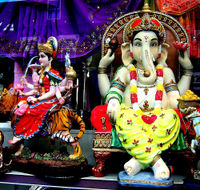
Before performing pūjā, the devotee usually bathes and wears washed clothes. Women customarily do not engage in pūjā during the first four days of menstruation. It is also customary for Hindus not to perform pūjā for a month after birth of a child (vṛddhi sūtak) or during the first sixteen days after the death of a family member (mritaka-sūtak). These periods are explained as resulting from a temporary state of ritual impurity (ashaucha).
Visiting temples is not obligatory for Hindus. Many Hindus go to temples only during religious festivals. Temples are not used for weddings, funerals, or as social hubs—they are primarily used for formal worship. Sometimes worship in temples is accompanied by devotional singing (kīrtana) and religious discourse. Hindu temple priests (pandās) are salaried workers, hired by temple authorities to perform ritualistic worship. They are not to be confused with swāmīs or sanyāsins (all-renouncing monks, who do not work for salary).
Priests begin to perform temple worship at daybreak, and continue with various rituals until late in the evening. During the worship the priest makes various offerings to God, such as food, drink, flowers, and perfume as a token of love, sacrifice and devotion. Often, devotees bring their own offerings to the temple, or purchase them from nearby vendors. Food offerings are called "Naivedhya". The priest takes the offering from the devotees and presents it to God on their behalf. Food that has been offered to God is considered to be sanctified (prasāda), and is generally distributed to the devotees, wandering monks or nuns, or the poor. Accepting prasāda is considered spiritually beneficial.
Besides home and temple worship, observant Hindus are supposed to perform every action as an offering to God as prescribed by karma yoga.
Worship of God through images
Hindus worship God through images ( murti), such as statues or paintings, which are symbols of God's power and glory. Through such tangible symbols a Hindu tries to establish contact with the intangible God and the image, which is a symbol, acts like a link between God and His worshipper.
According to another view, it is not incorrect to think that God is in the image because God is everywhere. Thus the Padma Purana states that the mūrti is not to be thought of as mere stone or wood but as the manifest form of the Divinity.
Although most mūrtis are more or less anthropomorphic, the deity Shiva is worshipped symbolically in the form of a pillar-like stone called a lingam.
A few Hindu denominations, such as the Arya Samaj, do not believe in worshipping God through images.
The guru-disciple tradition
In many Hindu denominations, spiritual aspirants are encouraged to have a personal spiritual teacher, called a guru. The student is expected to follow the instructions of the guru and to sincerely strive to reach the goal of spiritual life. Gurus may teach to each student a special mantra, which is a name of God, a holy phrase, or other sacred words, which the student repeats to himself or herself daily at dawn and dusk, and as much as possible at other times. The chanting of a mantra is called japa (see below). Japa is meant to increase remembrance of God and to elevate the mind so that it will become purer and able to experience God. A guru may also give a student instructions in meditation and other practices.
According to many systems of belief, a guru must never charge any money for the guidance that he or she gives, although a student may give voluntary gifts to the teacher as a token of appreciation (guru-dakshinā).
Japa and Mantra
Mantras are chanted, through their meaning, sound, and chanting style, to help a person focus the mind on holy thoughts or to express love and devotion for God. Mantras often give courage in exigent times and serve to help invoke one's inner spiritual strength. Indeed, Mahatma Gandhi's dying words are said to have been a two-word mantra to the Lord Rama: "Hé Ram!"
One of the most revered mantras in Hinduism is the Gayatri Mantra. In India including Kashmir, Brahmins are initiated into this most sacred mantra at the time of their Yajñopavit (thread ceremony). Many Hindus to this day, in a tradition that has continued unbroken from ancient times, perform morning ablutions at the bank of a sacred river while chanting the Gayatri and Mahamrityunjaya mantras.
Japa has been extolled as the greatest dharma for the Kali Yuga, in the Mahabharat.
Pilgrimage

Pilgrimage is not mandatory in Hinduism as it is in Islam. Nevertheless, many Hindus who can afford to do so undertake one or more pilgrimages during their lifetimes. There are many Hindu holy places (tīrtha-sthānas) in India. One of the most famous is the ancient city of Varanasi, otherwise known as Benaras or Kashi. Other holy places in India include Kedarnath and Badrinath in the Himalayas, the Jagannath temple at Puri, Rishikesh and Haridwar in the foothills of the Himalayas, Allahabad (also known by the ancient name Prayāg, located at the confluence of multiple holy rivers), Rameshwaram in the South and Gaya in the east. The largest single gathering of pilgrims is during the annual Kumbh Mela fair held in one of four different cities on a rotating basis. After visiting the Kumbh mela of 1895, Mark Twain wrote:
"It is wonderful, the power of a faith like that, that can make multitudes upon multitudes of the old and weak and the young and frail enter without hesitation or complaint upon such incredible journeys and endure the resultant miseries without repining. It is done in love, or it is done in fear; I do not know which it is. No matter what the impulse is, the act born of it is beyond imagination marvelous to our kind of people, the cold whites."
Satsang
Satsang is the practice of gathering for study or discussion of scripture and religious topics, or chanting of hymns. In Sanskrit, Satsang means circle, or, fellowship ('sangha') with truth ('sat'). People may gather under guidance of a sage, a priest, or a singer. This practice is sometimes called sādhu-sangha."
Devotional singing
Devotional singing, called bhajan or kirtan, is an important part of worship in many denominations. Devotional singing may take place in temples, in ashrams, on the banks of holy rivers, in the home, or elsewhere. Hymns may be in the ancient Sanskrit language, or in modern languages such as Hindi, Bengali, or Tamil. Musical instruments accompanying devotional singing frequently include the manjeera, tanpura, harmonium, and tabla.
Denominations
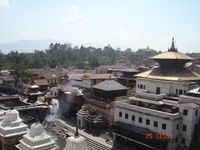
Many Hindus do not claim to belong to any particular denomination at all. However, scholars frequently categorize contemporary Hinduism into three or four major denominations: Vaishnavism, Shaivism, Shaktism, and sometimes Smartism or Advaita Vedanta. These denominations differ primarily in the particular forms of God worshipped, and in the rituals and traditions that accompany worship of that form of God. Vaishnavism worships God in the form of Viṣhṇu; Shaivism worships God as Shiva; Shaktism worships a female divinity or Goddess, Devī; while Smartism and Advaita Vedanta believe in an impersonal or pantheistic God without focusing on any particular form of God.
There are also many movements that are not easily placed in any of the above categories, such as Swami Dayananda Saraswati's Ārya Samāj, which condemns image worship and veneration of multiple deities, focusing instead on the Vedas and the Vedic fire sacrifices ( yajña). Traditions such as the Ramakrishna movement incorporate elements from all the major denominations and stress that God-realization can be achieved through any denomination so long as it is followed sincerely. In Tantra, the Goddess is considered the power of Shiva, and thus represents a combination of the Shaiva and shākta denominations.
As in every religion, some people view their own denomination as superior to others. In Hinduism, however, many Hindus consider other denominations to be legitimate alternatives to their own. The concept of heresy found in some other religions is therefore generally not an issue for Hindus.
History
Origins

The earliest evidence for elements of the Hindu faith is sometimes claimed to date back as far as the late Neolithic, to the Early Harappan period (ca. 5500–3300 BCE).
The beliefs and practices of the pre-classical era (ca. 1500-500 BCE) are often called the " Vedic religion." The oldest surviving textual document of Hinduism is the Rigveda, dated to between 1700–1100 BCE, based on linguistic and philological evidence.
The Vedic period
Modern Hinduism grew out of the knowledge described in the Vedas. The earliest of these, the Rigveda, centers on worship of deities such as Indra, Varuna and Agni, and on the Soma ritual. The early Indo-Aryans would perform fire-sacrifices, called yajña (यज्ञ), with the chanting of the Vedic mantras, but they built no temples, idols or icons. Probably animals were also sacrificed in larger yajñas, as claimed by Buddhist and Jain texts. The most ancient Vedic traditions exhibit strong similarities to Zoroastrianism, as well as to other Indo-European religions.
The influence of Buddhism & Jainism
The religions of Buddhism and Jainism arose in North India in the sixth century B.C. The Buddha accepted many tenets of Hinduism, but taught that to achieve salvation one did not have to accept the authority of the scriptures, the caste system, or even the existence of God. Many Hindus converted to Buddhism, and even many of those who did not convert were influenced by Buddhist teachings. Both Buddhism and Jainism influenced Hinduism with their emphasis on compassion for all life.
Epic & Puranic periods
The epic poems Ramayana and Mahabharata were written roughly 400 B.C. to A.D. 200, although they were probably transmitted orally for many years prior to this period. These epics contain both secular and mythological stories of the rulers and wars of ancient India, as well as stories about the avataras Rama and Krishna. The later Puranas recount tales about various Gods and Goddesses, their interactions with humans, and their battles against demons. The Gupta dynasty (c. A.D. 300-500) is associated with a proliferation of ornate art and extensive literature in the Sanskrit and Tamil languages.
Islam & Bhakti (12th-17th Centuries)
Beginning around 1173, successive waves of armies from Muslim countries invaded and, to varying degrees, consolidated control over North India. During this period Buddhism declined rapidly, and many Hindus converted to Islam. Some Muslim rulers destroyed Hindu temples and otherwise persecuted non-Muslims, while others, such as Akbar, were more tolerant.
Hinduism during this period underwent one of the most profound changes in its history, due in large part to the influence of the prominent teachers Ramanuja, Madhva, and Chaitanya. Followers of the Bhakti movement moved away from the abstract concept of Brahman to a focus on the more accessible avataras, especially Krishna and Rama. A new attitude toward God—emotional, passionate love—replaced the old approaches of sacrificial rite and meditation on the formless Absolute Principle.
Society
The four pursuits of life
Within the Grihastha Dharma there are four noble pursuits of life, known as puruṣhārthas. The four puruṣhārthas are:
- kāma (desire for sensual pleasure)
- artha (acquisition of worldly possessions or money)
- dharma (observance of religious duties)
- mokṣha (liberation achieved through God-realization)
Among these, dharma and moksha play a special role: the pursuit of kama and artha is only noble when pursued under the laws of dharma, with the ultimate goal, moksa, at the horizon.
Temples
Hindu temples inherited rich and ancient rituals and customs, and have occupied a special place in Hindu society. They are usually dedicated to a primary deity, called the presiding deity, and other subordinate deities associated with the main deity. However, some mandirs are dedicated to multiple deities. Most major temples are constructed as per the āgama shāstras and many are sites of pilgrimage. An important element of temple architecture and many Hindu households in general is Vaastu Shastra, the science of aesthetic and auspicious design.
Many Hindus view the four Shankarāchāryas (the abbots of the monasteries of Joshimath, Puri, Shringeri and Dwarka — four of the holiest pilgrimage centers — sometimes to which a fifth at Kanchi is also added) as the Patriarchs of Hinduism.
Ashramas (stages of life)
Traditionally, the life of a Hindu was divided into four Āshramas ("phases" or "stages"; unrelated meanings of āshrama include "monastery" or "refuge"). They are
- Brahmacharya ("meditation, or study of the Brahman"): life as a student
- Gṛihastha : the stage as a householder
- Vānaprastha ("living out in the forest"): the stage of retirement
- Sanyāsa: life as a monk.
The first quarter of one's life, Brahmacharya is spent in celibate, controlled, sober and pure contemplation under the guidance of a Guru, building up the mind for the realization of truth.
Grihastha is the householder's stage, in which one marries and satisfies kāma and artha within one's married and professional life respectively (see the pursuits of life). Among the moral obligations of a Hindu householder are the duties to support one's parents, children, guests, priests (Brahmins), and monks(sanyāsis).
Vānaprastha is gradual detachment from the material world. This may involve giving over duties to one's children, spending more time in contemplation of the Divine, and making holy pilgrimages.
Finally, in Sannyāsa, one renounces all worldly attachments, often envisioned as seclusion, to find the Divine through detachment from worldly life and peacefully shed the body for the next life (or for liberation).
Monasticism
In their quest to attain the spiritual goal of life, some Hindus choose the path of monasticism (sanyāsa). Monastics commit themselves to a life of simplicity, celibacy, detachment from worldly pursuits, and the contemplation of God. A Hindu monk is called a sanyāsī, sādhu, or swāmi. A female renunciate is called a sanyāsini. Renunciates are accorded high respect in Hindu society because their outward renunciation of selfishness and worldliness serves as an inspiration to householders who strive for mental renunciation, though this may not always be present as skepticism surrounds many such sadhus. Some monastics live in monasteries, while others wander from place to place, trusting in God alone to provide for their needs. It is considered a highly meritorious act for a householder to provide sādhus, or any brahmana, with food or other necessaries. Sādhus are meant to strive to treat all with respect and compassion, whether a person may be poor or rich, good or wicked, and also to be indifferent to praise, blame, pleasure, and pain. Sādhus often wear ochre-colored clothing, symbolizing renunciation, while some may have no clothes whatsoever.
Varnas & the caste system
Hindu society was traditionally divided into four classes, called varnas within what is commonly called the caste system. What varna a person was in was based on occupation —
- the Brāhmaṇas (also anglicised as Brahmins): teachers and priests;
- the Kṣhatriyas: warriors, kings and administrators;
- the Vaishyas: farmers, merchants, herdsmen and businessmen; and
- the Shūdras: servants and labourers.
Caste system has its root in Varnas, however, the caste system is not a creation of Hindu doctrines. For a survey of other theories regarding the origins of caste, see Elenanor Zelliot, "Caste in Contemporary India," in Contemporary Hinduism, Robert Rinehart, Ed. (2004) ISBN 1-57607-905-8</ref> The faith of the Shudras and Dalits allowed them to become great saints of Hinduism.
Today it is often debated whether the caste system is an integral part of the Hindu religion sanctioned by the scriptures or is simply an outdated social custom.
Although the scriptures contain some passages that can be interpreted to sanction the Varna system, they also contain indications that the caste system is not an essential part of the Hindu religion, and both sides in the debate are able to find scriptural support for their views.
Many social reformers, including Mahatma Gandhi (1869-1948), have criticized the problems caused by caste discrimination. The saint and religious teacher Sri Ramakrishna (1836-1886) taught that
lovers of God do not belong to any caste . . . . A brahmin without this love is no longer a brahmin. And a pariah with the love of God is no longer a pariah. Through bhakti (devotion to God) an untouchable becomes pure and elevated.
Ahimsa and vegetarianism
Hinduism advocates the practice of ahimsa (non-violence) and respect for all life because the divine soul is believed to permeate all. The term ahimsa first appears in the Upanishads, and is the first of the five Yamas, or eternal vows/restraints in Raja Yoga. The influences of Buddhism and Jainism helped to enhance the importance of ahimsa.
Related to the concept of ahimsa, many Hindus embrace vegetarianism in a bid to respect higher forms of life. While vegetarianism is not a dogma or requirement of Hinduism, it is recommended as a sattwic (purifying) lifestyle. As of 2006, about 30% of the population in India is lacto-vegetarian but the food habits usually vary with community (caste) and region. For instance, the Aadivasi as well as the coastal habitants in India are largely non-vegetarian, with vegetarianism dominant in landlocked states of northern and western India, states like Gujarat (with Jainand Vaishnavic influence), and in many Brahmin and Marwari enclaves around the subcontinent. Some Hindus avoid even onion and garlic, which are regarded as rajasic foods. Another 20% of Hindus avoid meat on specific holy days.
Even Hindus who do eat meat, generally abstain from beef. Some even avoid products made from cow's leather. This is presumably because the largely pastoral Vedic people, and subsequent generations, relied so heavily on the cow for milk and dairy products, tilling of fields and as a provider of fuel and fertilizer, that it was identified as a caretaker and a maternal figure (hence the term gau mata, or Cow Mother). While most contemporary Hindus do not worship the cow (though many venerate her), the cow still holds an honored place in Hindu society as a symbol of unselfish giving. Cow-slaughter is legally banned in almost all states of the Indian Union.
Hindu festivals
Hinduism has many festivals distributed throughout the year. Their dates are usually prescribed by the Hindu calendar and typically celebrate events from Hindu mythology, often coinciding with seasonal changes and occasions of importance in an agricultural economy.
Some widely observed Hindu festivals are,
- Dussera, or Durga Puja, celebrates events from Hindu mythology symbolizing the triumph of good over evil;
- Diwali, also known as the festival of lights;
- Ganesh Chaturthi, the festival celebrating Lord Ganesha;
- Maha Shivaratri, the festival dedicated to Lord Shiva;
- Ramanavami, celebrates the birth of Lord Ram, the seventh incarnation of Lord Vishnu;
- Krishna Janmastami, celebrates the birth of Lord Krishna, the eighth incarnation of Lord Vishnu;
- Holi, the spring festival of colors and light.
- Sankranthi, Harvest festival of India, celebrated in mid of January every year.
Besides these there many other Hindu festivals, some of which are celebrated primarily by specific denominations or in certain regions of the Indian subcontinent.
Conversion
Since the Hindu scriptures are essentially silent on the issue of religious conversion, the question of whether Hindus should evangelize is open to interpretations. Those who see Hinduism primarily as a philosophy, a set of beliefs, or a way of life generally believe that one can convert to Hinduism by incorporating Hindu beliefs into one's life and by considering oneself a Hindu. However, those who view Hinduism as an ethnicity more than as a religion tend to believe that to be a Hindu, one must be born a Hindu. The Supreme Court of India has taken the former view, holding that the question of whether a person is a Hindu should be determined by the person's belief system, not by their ethnic or racial heritage.
There is no formal process for conversion to Hinduism, although in many denominations a ritual called dīkshā ("initiation") marks the beginning of spiritual life, much like baptism in Christianity. Most Hindu denominations do not actively seek to recruit converts because they believe that the goals of spiritual life can be attained through any religion, as long as the religion is practiced sincerely. Nevertheless, Hindu "missionary" groups operate in various countries to provide spiritual guidance to persons of any religion, irrespective of their conversion to Hinduism. Examples include the Vedanta Society (also known as the Ramakrishna Mission) and the Self-Realization Fellowship.
Schools of Hindu philosophy
The six Āstika or orthodox schools (those which accept the authority of the Vedas) of Hindu philosophy are Nyāya, Vaisheṣhika, Sāṃkhya, Yoga, Pūrva Mīmāṃsā (also simply called Mīmāṃsā), and Uttara Mīmāṃsā (also called Vedānta). The six schools are known as "Shat Astik (Hindu) Darshana."
The Heterodox Nāstika schools—those which do not rely on the authority of the Vedas—are Buddhism, Jainism and Lokāyata.
Although these philosophies are usually studied formally only by scholars, their influences can be found in many religious books and beliefs held by average Hindus.
Themes and symbols
Tilaka
The tilaka (or tilak) is a mark worn on the forehead and other parts of the body for spiritual reasons. Hindus traditionally wear tilaka, in one form or another, as a mark of faith in a particular tradition. Hindus may wear tilaka always or especially on religious occasions. The shape of the tilaka often represents devotion to a certain deity. For example, a 'U' shape tilaka usually denotes someone as a devotee of Vishnu.
To denote marriage and auspiciousness, married women today commonly wear on the forehead a decorative dot, or bindī. In Southern India, this is called pottu (or bottu). Normally a red bindi or pottu is worn by married women on the central upper portion of the forehead where the hair starts.
Vibhuti
Vibhuti is the holy ash obtained from sacred puja rites involving fire. It is used on the forehead, normally as three horizontal lines representing Shiva. Some Hindus meld both the three horizontal vibhuti lines of Shiva and the 'U' shape thilaka of Vishnu in an amalgam marker signifying Hari-Hara (Vishnu-Shiva).
Symbolism
Among the most revered symbols in Hinduism, three are quintessentially a part of its culture, and representative of its general ethos:
Aum (or Om, ॐ) is the sacred symbol that represents God (Brahman). It is prefixed and sometimes suffixed to all Vedic mantras and prayers. It is often said to represent God in the three aspects of Vishnu (A), Shiva (U) and Brahmā (M). As the divine primordial vibration, it represents the one ultimate reality, underlying and encompassing all of nature and all of existence. The written syllable serves as a deeply significant and distinctly recognizable symbol for Hindu dharma.
Swastika is a symbol connoting general auspiciousness. It may represent purity of soul, truth, and stability or, alternatively, Surya, the sun. Its rotation in four directions has been used to represent many ideas, but primarily describes the four directions, the four Vedas and their harmonious whole. Its use in Hinduism dates back to ancient times. Nazism used a tilted version of this symbol under the name Hakenkreuz, and associated it with the notion of "purity of race".
Sri Chakra Yantra or Yantra of Tripura Sundari (commonly referred to as Sri Yantra) is a mandala formed by nine interlocking triangles. Four of these triangles are orientated upright representing Shiva - the masculine. Five of these triangles are inverted triangles represent Shakti - the feminine. Together the nine triangles form a web symbolic of the entire cosmos, a womb symbolic of creation and together express non-duality. All other yantras are derivatives of this supreme yantra.


